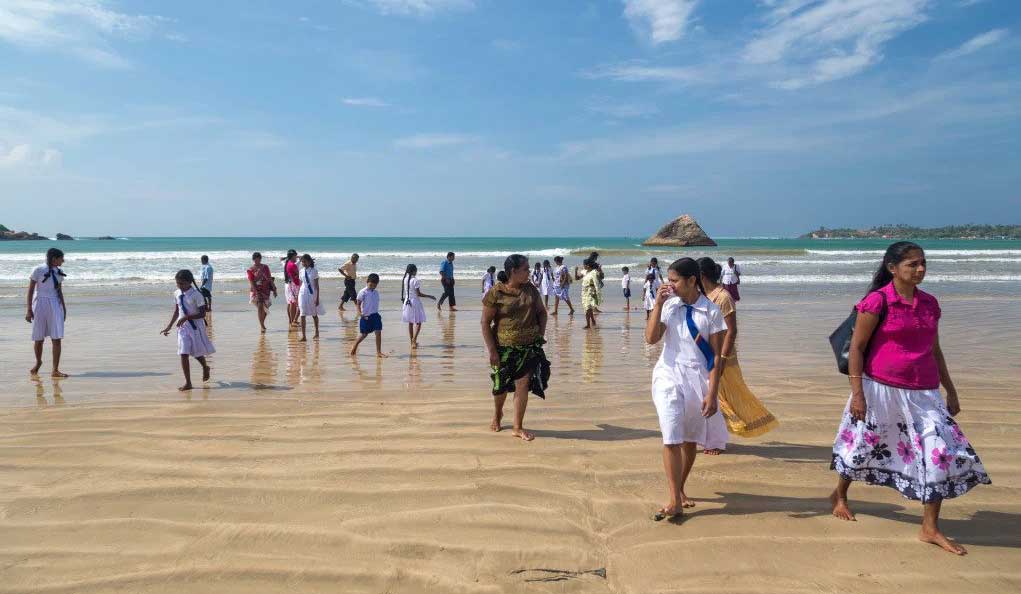The Age – April 25, 2023
One of the reasons I’m not really a fan of big, organised tours is that you never get the chance to go free range in a destination. Everything you see and do is packaged and proscribed. The story is worked out ahead and you have to fit into it.
It’s the people you meet spontaneously who make the experience wonderful, more than beautiful vistas or wiggling your toes in white sand. At least, for me.
I’m just back from Sri Lanka, a country where the hospitality and friendliness of local people to strangers is off the charts.
Two things stand from this trip. One is a lesson in what we as travellers can do for the people of our host country. The other is what they can do for us.
The tiny village of Rathmale near Sri Lanka’s south coast amounts to not much more than a small market, a couple of streets of shops and two barbers. There’s an intersection of two roads, a few dogs, and that’s about it.
I was with a few friends wandering the market when a young girl came up to us and asked if she could practise her English. Her name was Upeksha, she said, and she and her dad had been driving by on his scooter, when he suggested she try out her language skills on the tourists. (Great dad, by the way.)
She was in her late teens and studying English at school, she told us. She was so bright and personable, and her English was pretty good. She said she was so happy that we had agreed to speak to her.
I asked her what she wanted to do when she left school. “I want to be a fashion designer,” she said. As it happened, in our small group was an editor from Harper’s Bazaar in Asia. Many of us had fashion experience, so we spent a long time encouraging her, and there was an exchange of WhatsApp numbers, so she could contact the editor for advice.
“I am so lucky to meet you,” she beamed. Never in her wildest dreams could she have imagined she could meet such people. Dad came by to pick her up, and they drove away, both wearing the biggest smiles you could imagine.
A few days later, I was staying in a resort on the south-west coast, near the town of Ahungalla. The resort sat in a small, modest village of small houses and shacks along a shady lane. I went for a stroll in the village and many people came out to say hello.
One of them was a woman standing in the driveway of a larger house, which looked quite new. I said how much I liked her house. “Would you like to come in and see it?” she asked. Of course I would!
Ranmali made my husband and I strong, sweet tea and brought out some biscuits. They were living in their son’s house, they explained. He and their daughter were in Romania, working in hospitality. They were looking after their grandson. The house was full of toys. She showed us her grandson’s very neat homework.
She then brought out all the family photos and then made a video call to her son on WhatsApp to say hello. We showed her our family photos in exchange. “You can stay with us next time,” she offered.
Her husband volunteered to take us across the road to their temple, which overlooked the sea. We agreed, not expecting much. As it turned out it was an exquisite 300-year-old monastery with small rooms full of ancient wall paintings and many brightly painted Buddhist statues. It included rooms that held enormous, intricately carved Hindu gods.
The monk (one of three) showed us around and gave me a porcupine quill as a gift.
We wouldn’t have gone there if I hadn’t had this fortuitous meeting in the lane with Ranmali. And if we hadn’t been open to meeting strangers without suspicion. And if they hadn’t been open to us.
I stayed in several beautiful resorts along the Sri Lankan coast this trip, but my memories of the people are the most cherished.
Perhaps you need to be a people person, but there are many benefits when you leave the confines of your tour or hotel room and get down among the locals.
The best thing I gained from this trip was the restored faith in my fellow humans.
Photo by – The locals in Sri Lanka are better than the beaches.CREDIT:ISTOCK

